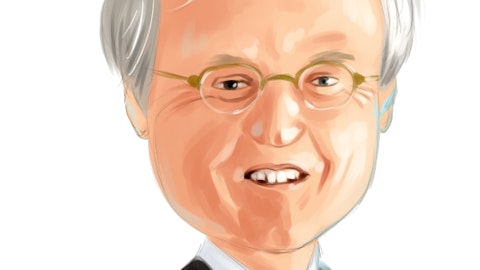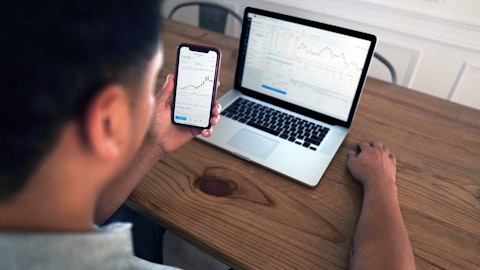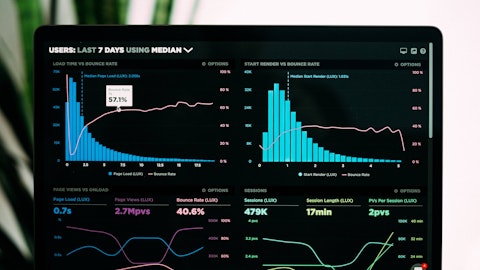Williams-Sonoma, Inc. (NYSE:WSM) Q3 2022 Earnings Call Transcript November 17, 2022
Williams-Sonoma, Inc. beats earnings expectations. Reported EPS is $3.72, expectations were $3.71.
Operator: Welcome to the Williams-Sonoma Third Quarter 2022 Earnings Conference Call. At this time, all participants are in a listen-only mode. A question-and-answer session will follow the conclusion of the prepared remarks. I would now like to turn the call over to Jeremy Brooks, Chief Accounting Officer and Head of Investor Relations. Please go ahead.
Jeremy Brooks: Good afternoon, and thank you for joining our third quarter earnings call. I’d like to remind you that during the call, we will make forward-looking statements with respect to future events and financial performance, including guidance for fiscal ’22. We believe these statements reflect our best estimates. However, we cannot make any assurances that these statements will materialize, and actual results may differ significantly from our expectations. The company undertakes no obligation to publicly update or revise any of these statements to reflect events or circumstances that may arise after today’s call. Additionally, we will refer to certain non-GAAP financial measures. These measures should not be considered replacements for and should be read together with our GAAP results.
A reconciliation of non-GAAP measures to the most directly comparable GAAP measures appears in Exhibit 1 to the press release we issued earlier today. The call should also be considered in conjunction with our filings with the SEC. Finally, a replay will be available on our Investor Relations website. Now, I’d like to turn the call over to Laura Alber, our President and Chief Executive Officer.

Photo by Vladimir Gladkov on Unsplash
Laura Alber: Thank you, Jeremy, and good afternoon, everyone. We are proud of another strong quarter, generating an 8.1% comp or 25% on a two-year basis and 50% comp growth on a three-year basis, with record EPS growth of 12% over last year to $3.72 per share. These results reflect the continuation of backlog order fulfillment, strong product margins and disciplined cost control. Demand comps for the quarter were slightly negative. This continued outperformance reflects the unique strength of our multi-brand portfolio, our growth initiatives, and ongoing execution of our talented team. Since we last spoke, the macro backdrop has become more uncertain. However, what has not changed is the large and fragmented space in which we operate, where no one player owns significant market share.
We believe we have an ability to capture more of this market in any environment. We have and will continue to deliver results, leveraging our key differentiators, our in-house design, our digital first but not digital-only capabilities and our value. These competitive advantages in combination with our growth strategies give us many opportunities for the future. As we talked about before, one of our largest is B2B, which had another excellent quarter, driving over $30 million in demand, a 17% increase to last year. We continue to believe our B2B business presents a sizable growth driver for us as it disrupts an underserved estimated $80 billion total addressable market. B2B is building velocity with large and repeat projects from commercial and hospitality partners like Marriott and Hilton.
We are also focused on diversifying into new industry verticals, including the healthcare space through multi-property partnerships with national accounts. In September, we successfully launched our improved corporate gifting and custom merchandise services, and we are encouraged by the early success leading into the holiday season. A key B2B customer of ours for over three years now is Starbucks. We are thrilled to publicly announce that our team was able to assist Starbucks with the build-out of their gorgeous three-storey flagship reserve store in the Empire State Building. In addition to incorporating furniture from Brooklyn-based West Elm, our B2B team had the opportunity to work with Starbucks to create custom furniture solutions to meet their unique needs.
We look forward to growing our existing relationship with Starbucks. And now I’d like to talk about our global business where we continue to expand in key markets and grow our multichannel presence. In Q3, we saw strength in both franchise and company-owned. In the franchise business, we believe that one of our biggest opportunities is in India. And after launching our website earlier this year, we opened our first Pottery Barn store in New Delhi, joining our West Elm stores in New Delhi and Mumbai. We plan to continue to focus on in India and in early 2023, will be adding stores across our brands and continuing to improve our online experience with our great partner, the Reliance Group. In our company-owned business, I want to highlight Canada where we successfully relaunched our website this year across all the brands, driving order fulfillment and an improved omni experience.
Another important initiative is sustainability for which we continue to be recognized for our Impact initiative and ESG leadership across the home furnishing industry. In Q3, we were named a top score on Sustainable Furnishings Counsel Wood Furniture Scorecard for the fifth consecutive year, and West Elm received The Forest Stewardship Council Leadership Award for its use of FSC certified wood. We recognize there is much more work to do in this space, and we are committed to continuing to be a leader in planet, people and purpose. One of our sustainability initiatives is our goal to plant 6 million trees across our family of brands in partnership with the Arbor Day Foundation. We are excited to report that we have planted over 2 million trees to date.
Now, let’s turn to the performance of our brands. Pottery Barn delivered yet another very strong quarter with a 19.6% comp or 35.5% on a two-year stack and almost 60% on a three-year stack. Pottery Barn continues to perform offering exclusive high-quality inspirational products, and strategic growth areas like apartment, marketplace and bath reno are driving results. We’re particularly proud of our Accessible Home collection, which launched in late July and has quickly scaled. West Elm delivered a 4.2% comp in the third quarter or 26.6% on a 2-year stack and 48.4% on a 3-year basis. During the quarter, we improved our in-stock inventory position, and we expect to continue to make improvements in our service levels into Q4 and next year. We are also very focused on improving our e-commerce experience and customer-facing conversion-driving initiatives.
I’ve had the opportunity to spend a lot of time with West Elm this quarter, and I am very impressed with the talented and passionate team running the brand. Our greatest opportunity at West Elm is doubling down on what has made this brand great, our commitment to design innovation and value price points. Now, I’d like to update you on the Pottery Barn children’s home furnishings business, which ran a negative 4.8% comp in Q3, but a positive 12.1% on a 2-year basis and a positive 35.9% on a 3-year basis. We continue to see ongoing recovery in our in-stocks. And looking to the future, we have a strong pipeline of products at compelling values. The Williams-Sonoma brand ran a negative 1.5% comp in Q3, but a positive 6.1% on a 2-year and a positive 36.5% on a 3-year basis.
We continue to see that people are hosting and entertaining at home. And as such, we saw strength in entertaining areas. In Q3, we successfully kicked off the holiday season with our exclusive collaboration with celebrity chef and author, Ina Garten. As part of this collaboration, Ina shares Thanksgiving tips for cooking and hosting the ultimate Thanksgiving dinner party. We also announced the exciting launch of a collaboration with renowned British heritage textile brand, William Morris & Company. Williams-Sonoma Home delivered another double-digit comp in Q3. We continue to see this business as an opportunity to deliver outsized growth by picking up market share from the limited luxury high-end home market. We’re excited to launch an expanded furnishing line for the kitchen in Q4.
As we look to the holiday season, we are prepared to meet the needs of our gift giving customers with compelling product offerings. Our stores are a competitive advantage, and they are stocked and our associates are ready to serve our customers. And finally, our emerging brands, including Rejuv and Mark and Graham, together, they ran a 7.8% comp this quarter. At Rejuvenation, we saw success in remodel categories related to kitchen and bathroom, including vanities, cabinet hardware and wall lighting. And at Mark and Graham wins were from the travel category, including luggage and travel accessories. We are proud of our third quarter results. but we are also aware that economic uncertainty is on the minds of consumers and investors alike. During the third quarter, we experienced deceleration and choppiness in our demand, and it is hard to know where the economy is going or how long the uncertainty will last.
Nonetheless, we are controlling what we can control and looking at opportunities to reduce costs without an impact to the customer experience. In fact, we believe that protecting service and innovation is key to outperforming our peers. As it relates to pricing, we continue to be committed to not running site-wide promotions as we did before the pandemic, but we will continue to markdown and clear overstocks. We are working with our vendors to reduce costs and pass on that value strategically to our customers. As for additional expenses, out of market and redundant shipping expenses and transportation costs have negatively impacted our gross margin. We continue to focus on these pressures, and mitigation of these costs will be a significant benefit for us in the future, particularly in the second half of next year.
In summary, we are conscious that the home furnishings market may contract due to macro factors. If this happens, we believe we are uniquely positioned to take market share, even if there is a downturn, and here’s why. We built a company of loved brands with a shared platform of competitive differentiators that leads the industry, in-house design, digital first but not digital-only platform and our value. We have identified opportunities for growth through strategic initiatives like B2B, global end marketplace where we have the opportunity to disrupt. And finally, we have a culture of innovation and an experienced team who knows how to increase operational efficiencies and control costs while protecting service and driving new growth opportunities.
Now, I will turn it over to Jeff to walk you through the results in more detail in his first earnings call as CFO.
See also 11 Best Travel Stocks To Buy and 12 Best Affordable Stocks To Buy Under $5.
Jeff Howie: Thank you, Laura, and hello, everyone. I am so pleased to join you today for my first earnings call in my new role as Chief Financial Officer. While I’m relatively new to this particular role, I’m a 20-year member of the Williams-Sonoma leadership team. I come into this role with deep knowledge and experience across our brands, operations and financials. I look forward to applying my breadth and depth of experience to drive continued strong results. Diving into our third quarter results. We delivered another quarter of record revenues and earnings in a challenging environment. Our top line results illustrate our ability to gain market share. Our bottom line results demonstrate the power of our operating model to sustain merchandise margins and control SG&A expenses.
Net revenues grew to $2.2 billion, with comparable brand revenue growth at 8.1% for a 2-year comp of 25% and a 3-year comp of almost 50%. Our revenue growth was driven by strong order fulfillment, ongoing momentum in our growth initiatives and our continued ability to take market share, even as we experienced inconsistent demand within our portfolio of brands and across the quarter. Both channels continued to experience strong growth, with retail at a 16.9% comp and e-commerce at a 4.4% comp. Moving down the income statement. Gross margin was 41.5%, 220 basis points below last year and in line with our expectations. We sustained strong merchandise margins that were flat year-over-year. We remain committed to our decision to no longer offer site-wide promotions and preserve the pricing integrity, our proprietary, differentiated product commands.
The strength of these merchandise margins is particularly impressive given we absorbed significant cost increases from our vendors and ocean carriers, including higher demurrage and detention charges. As expected, the gross margin decline was driven by higher outbound shipping costs. This is due to our increased furniture mix, higher backorder fulfillment and incremental freight costs. We also incurred higher costs to best serve our customers by shipping from out-of-market distribution centers and in some cases, shipping multiple times for multiunit orders, which typically would have been fulfilled in a single shipment. Occupancy costs at 9.2% of net revenues were 30 basis points above last year with occupancy dollars increasing 10.5% to approximately $202 million.
Our ongoing retail store optimization initiative partially offset incremental costs from our new distribution centers on both, the East and West Coast. These new distribution centers will support our long-term growth, improve service time for our customers and drive cost efficiencies over time. Our SG&A rate continues to be at historic lows at 26%, leveraging 150 basis points over last year, driven by advertising and employment leverage. Our advertising leverage reflects the agile, performance-driven proficiency of our marketing team, our in-house capabilities, first-party data and multi-brand platform allow us to test, learn and scale, which is a unique competitive advantage. Our SG&A leverage also reflects our culture of financial discipline, where we consistently challenge all expenses for return on investment and drive operational efficiency throughout the Company.
On the bottom line, we delivered another record quarter of earnings. Q3 operating income grew 2% to $340 million, and we delivered strong operating margin at 15.5%, only 80 basis points below last year, despite significant headwinds and cost pressures. Our diluted earnings per share of $3.72 was up 12% from last year’s record third quarter earnings per share of $3.32. On the balance sheet, we ended the quarter with a cash balance of $113 million, with no debt outstanding and year-to-date operating cash flow of $588 million. That enabled us to fund the operations of the business and expand our capital investments to support our long-term growth. In addition, year-to-date, we have returned excess cash of over $1 billion to shareholders through $165 million in dividends and $840 million in share repurchases.
These decisions reflect our commitment to maximizing returns for our shareholders. And with our strong and disciplined balance sheet, combined with our expected free cash flow, we have flexibility to continue to invest in the growth of the business and opportunistically invest in our own stock and drive long-term shareholder returns. Moving down the balance sheet. Merchandise inventories which include in-transit were $1,688 million, increasing 33% over our reduced level of last year. Inventory on hand increased 34% over last year, but was up only 11% to 2019 versus sales up 52% over the same time. In the quarter, backorder levels decreased but remained well above historical levels. We are working hard to get these goods in to fulfill our customer orders, but continue to anticipate our backorder levels will remain elevated in the first half of ’23.
Summarizing our Q3 results, we are proud to have delivered another quarter of record revenues and earnings. I would like to thank all our associates for their hard work and dedication in driving these great results. Now, turning to our expectations for the remainder of the year and beyond. We acknowledge that the near-term macroeconomic picture remains uncertain with conflicting economic signals surrounding consumer spending trends, decade high inflation and Federal Reserve monetary policy, intentionally moderating economic demand. Additionally, our trends have been increasingly inconsistent and less predictable. This combination of conflicting economic signals and inconsistent trends makes our guidance unusually difficult to predict. However, we remain confident in our ability to operate in any environment and are therefore reiterating our fiscal year ’22 guidance of mid to high single-digit revenue growth with operating margins relatively in line with fiscal year ’21.
Our outlook is grounded in three factors. First, we are currently in the early stages of our upcoming holiday seasonal ramp with the biggest weeks yet to come. Second, our Q3 quarter demand trends support a wide range of outcomes. And third, the ongoing improvement we see in fulfillment of our customer order backlog. From a profitability perspective, as we said in our last call, we continue to expect cost pressures to persist for the balance of fiscal year ’22 and into the first half of ’23, primarily across our supply chain. These headwinds include our incremental distribution centers, higher product and freight costs, and our efforts to best serve our customers by delivering products as timely as possible. Our capital allocation strategy remains unchanged.
In fiscal year ’22, we expect capital expenditures will be approximately $350 million. We plan to continue to return excess cash to our shareholders through quarterly dividend and opportunistic share repurchases. While the near term may be uncertain, the current management team has successfully navigated challenging environments before, including the 2008 great financial crisis and the 2020 global pandemic. We know the levers to pull, and we have already taken steps to reduce cost and inventory to mitigate downside risk. Given the increased macro uncertainty, we will not be reiterating or updating our fiscal year 24 guidance at this time. We will be providing guidance for fiscal year ’23 and beyond at our next call. We remain confident in the long-term fundamentals of our business.
Our confidence remains rooted in our ability to take market share in the fractured home furnishings industry, the strength of our in-house proprietary design, the competitive advantage of our digital first but not digital-only channel strategy, the ongoing strength of our growth initiatives and the resiliency of our fortress balance sheet. And having been here before, we see opportunity to take an offensive stance in a challenging macro environment. In summary, we are very proud of our results. We continue to deliver for our customers, our associates and our shareholders. And now, I’d like to open the call for questions. Thank you.
Q&A Session
Follow Williams Sonoma Inc (NYSE:WSM)
Follow Williams Sonoma Inc (NYSE:WSM)
Operator: Your first question comes from the line of Peter Benedict with Baird.
Peter Benedict: First one is on inventory. Just wanted — maybe you could give us a little more color, your comfort with the current makeup furniture versus non-furniture. It sounds like you’ve adjusted some receipts, I guess, in response to the slower — or the softer macro. But how should we think about the level of inventory that you’d be comfortable operating with? I think you’re about 120 days currently. I think you used to run like 100 days pre-COVID. I don’t know, like any benchmark to help us think about as we move through next year, how inventory might look depending on different sales scenarios? That’s my first question. Thank you.
Laura Alber: Thanks, Peter. I’m going to let Jeff take that one.
Jeff Howie: Good afternoon, Peter. When you think about inventory, I really think it’s tough to look at it on a one-year basis. I know we’re up 33%. But if you think about this time last year, we were at our most aggressive inventory levels. because if you think back to last year, that’s when Southeast Asia was really closed, and we were still seeing the residual impacts of the COVID closures from India and China. So, we were at our lowest inventory levels at that point. We really like to look at it on a three-year basis, where our three-year on-hand inventory is up 12% versus our sales up 52% over the same time period. How we’re thinking about it is we’re making progress, but there’s still a lot more work to do. Our backlog remains at historically high levels, and we’re working hard to get our composition right as well as our location of our inventory to service our customer best.
We anticipate our inventory levels and our backorders to gradually improve through Q4 and in the first half of ’23.
Peter Benedict: Okay. Great. That’s helpful. And then my second question, I know it’s an unpredictable environment, but you did — you have some line of sight here, I think in terms of the out-of-market shipments and the other items that you said would provide some saving. Any way you can maybe help frame the size of those opportunities as we think about the back half of ’23 as those start to come into the P&L. Thanks so much.
Jeff Howie: Thanks, Peter. I think that’s a great question, and it’s really how we’re looking at it. So, we have tremendous headwinds right now, particularly on our gross margin from higher product costs, higher inbound ocean costs, and as you mentioned, higher out-of-market costs, as well as shipping multiple shipments to the same customer for the same order when we should really be shipping at once. That right now for the Q4 and into the first half of ’23 is a headwind, and it will be impacting our margin. But we’re pretty optimistic as we look to the back half of ’23 and into ’24. This is going to be a substantial tailwind and give us a lot of room to sustain our margins.
Operator: Your next question comes from the line of Steve Shemesh with RBC Capital Markets.
Steve Shemesh: First one is on the slightly negative demand comp in the quarter. Can you share any additional perspective on how demand trended throughout the quarter, and I guess where we stand in the first few weeks of November? And then as a follow-up on the backlog, I mean, it seems like the supply chain lead times improved pretty meaningfully throughout the quarter. Just curious if that materially changes your view on when you’ll clear the backlog. I know you still said first half ’23, but to the extent that’s true, just curious why that wouldn’t clear sooner.





